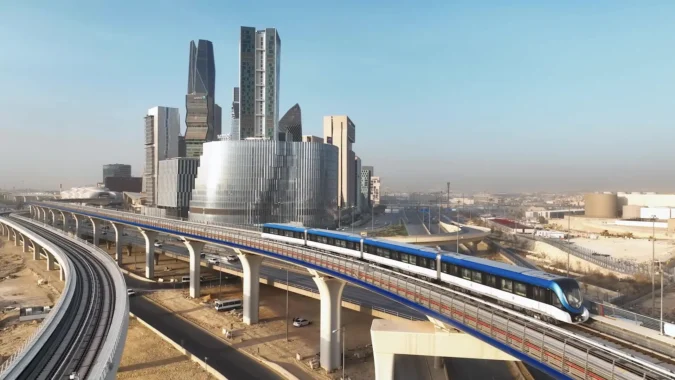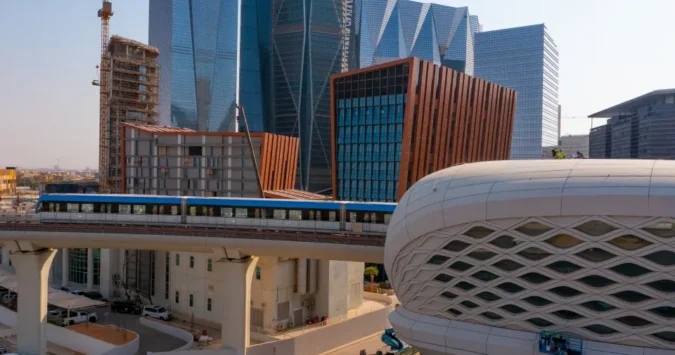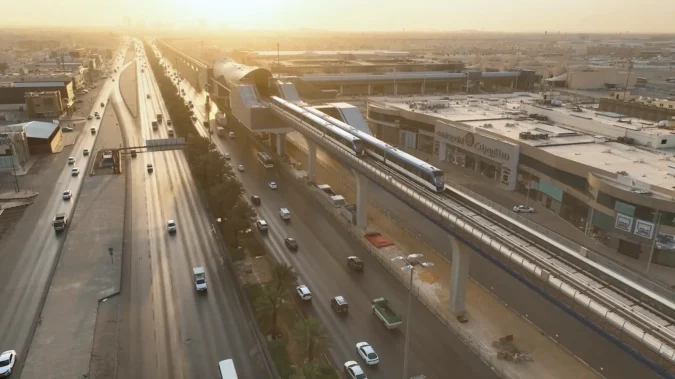Riyadh Metro project

Riyadh Metro Project
A New Way to Move in Saudi Arabia’s Capital. This massive transit system spans 176 kilometers. It’s the world’s longest driverless metro, with 85 stations connecting every corner of Riyadh.
Riyadh Metro Project – Powering a Smarter, Greener Capital
Riyadh Metro transforms travel across Saudi Arabia’s vibrant capital. Launched in November 2024, this system drives Saudi Vision 2030’s dream of a global, sustainable city. It fights traffic jams, cuts pollution, and connects people like never before. Residents zip to work faster. Tourists visit landmarks like the National Museum with ease. Investors find new opportunities in a growing hub. Urban planners admire its smart design.
This metro moves 1.2 million passengers daily, easing crowded streets. Its sleek trains and iconic stations, like Zaha Hadid’s KAFD, blend tech with beauty. Curious about its lines, tech, or green impact? This guide explores the metro’s routes, smart systems, sustainability, and role in Riyadh’s future.
Riyadh Metro project reshapes travel in Saudi Arabia’s capital. It’s part of the King Abdulaziz Project for Riyadh Public Transport. This $22.5 billion system tackles traffic jams and supports a growing city. Riyadh’s population, now 7 million, will hit 8 million by 2030.

The riyadh metro project companies eases crowded roads for everyone. It aligns with Saudi Vision 2030, pushing for a modern, green city. King Salman launched it on November 27, 2024, with services starting December 1. The metro spans 176 kilometers across six lines. Its 85 stations connect homes, offices, and cultural sites.
Driverless trains carry 1.2 million passengers daily, with room for 3.6 million. Lines opened in phases: Lines 1, 4, and 6 began December 1, 2024. Lines 2 and 5 started December 15. Line 3 joined on January 5, 2025. This setup makes Riyadh a global transit leader.
Exploring the Riyadh Metro Project : Lines and Stations
Riyadh Metro project has six color-coded lines connect the capital’s heart. These lines—Blue, Red, Orange, Yellow, Green, Purple—span 176 kilometers. They link 85 stations, making travel fast and easy. Each line serves a unique purpose. Residents, tourists, and visitors find every corner of Riyadh accessible. The metro’s design blends function with beauty, showcasing Saudi Arabia’s bold vision.
- Blue Line (Line 1) runs 38 kilometers with 22 stations. It cuts through central Riyadh along Olaya and Al Batha roads. Commuters reach downtown shops and offices quickly.
- Red Line (Line 2) covers 25.3 kilometers with 13 stations. It follows King Abdullah Road, perfect for business districts.
- Orange Line (Line 3), the longest at 40.7 kilometers, connects west to east. It links Madina Al Munawwara to Rahman Al Awal Road.
- Yellow Line (Line 4) stretches 29 kilometers to King Khalid International Airport. Tourists land and ride straight to the city.
- Green Line (Line 5) and Purple Line (Line 6) weave through key neighborhoods, boosting local access.
Iconic metro stations stand out. King Abdullah Financial District (KAFD) station, designed by Zaha Hadid, looks like a futuristic wave. Its sleek curves draw global attention. National Museum station, spanning 72,000 square meters, mimics a mountain’s rugged beauty. Its bus terminal echoes a Bedouin tent. Qasr Al Hokm, crafted by Snøhetta, blends modern design with Saudi heritage. These stations aren’t just stops—they’re landmarks.
Four major transit hubs shine: KAFD, National Museum, STC, and Qasr Al Hokm. They offer parking lots for drivers. Buses connect seamlessly, with 80 routes citywide. Shops and cafes add convenience for travelers. KAFD station links Lines 1, 4, and 6, bustling with activity. STC hub connects workers to offices. These hubs make switching lines or modes simple.
Cutting-Edge Technology and Innovation
Riyadh Metro Project leads the world with smart technology. Its driverless metro runs on Communication-Based Train Control (CBTC). This system guides trains without human drivers. CBTC tracks every train’s position in real time. It ensures smooth, safe rides across 176 kilometers. Five control centers monitor operations day and night. This tech makes Riyadh a global transit star.

The Bacs riyadh metro project uses three top train types. Siemens Inspiro trains power Lines 1 and 2 with sleek designs. Bombardier Innovia Metro 300 trains run Line 3, built for speed. Alstom Metropolis trains serve other lines, offering comfort. All trains have air-conditioning and save energy. They carry 1.2 million passengers daily, with room for more. These trains keep Riyadh moving fast.
Smart ticketing makes rides easy. NFC-enabled cards let you tap and go. The Darb app shows fares and schedules. A single ticket costs SAR 4 for two hours. Daily, weekly, or monthly passes save money. This system speeds up boarding for everyone. Tourists and residents love the simple payments. Check the Darb app for real-time updates.
Safety comes first. CCTV cameras watch every station. Real-time monitoring spots issues instantly. Early warning systems stop problems fast. Firefighting tools protect passengers. Stations welcome people with disabilities. Ramps, elevators, and clear signs ensure easy access. AI crowd management keeps platforms safe during busy times. These features build trust for all riders.
Sustainability and Environmental Impact
Riyadh Metro project drives a greener future for Saudi Arabia’s capital. Its stations use solar power, cutting energy use by 20%. Solar panels soak up sunlight to cool and light platforms. This saves electricity and lowers costs. The metro earns LEED Silver certification for its eco-friendly design. Builders chose recyclable materials for stations and tracks. These choices keep waste low and the city clean.
The metro slashes carbon emissions. Riyadh’s 7 million people rely on cars, clogging roads and polluting air. The metro moves 1.2 million passengers daily, reducing car trips. Fewer cars mean less traffic and cleaner skies. Studies show public transit cuts urban emissions significantly. Riyadh Metro project helps the city breathe easier. It supports healthier lives for residents and visitors.
This eco-friendly infrastructure fits Saudi Vision 2030’s green goals. The metro aligns with the Green Riyadh Initiative, planting trees citywide. Together, they fight climate change and boost sustainability. By 2030, the metro aims to raise public transit use from 2% to 18%. This shift shrinks Riyadh’s carbon footprint. Tourists enjoy cleaner streets. Investors see a city ready for a sustainable future.
Economic and Social Benefits
Challenges and Opportunities for Adoption
Riyadh Metro project faces hurdles but offers big wins. Car dependency grips the city’s 7 million residents. Most prefer driving over public transit. Hot weather makes walking to stations tough. Sidewalks often lack shade or safe paths. Transfer times between lines slow some trips. These modal shift challenges limit metro use. Yet, solutions are on the way.
Opportunities spark hope for public transport adoption. Transit-oriented development (TOD) reshapes neighborhoods around stations. New shops, homes, and offices near KAFD station draw riders. Improved pedestrian infrastructure adds shaded walkways and crosswalks. These changes make stations easier to reach. Planners aim to boost metro use from 2% to 18% by 2030. This shift cuts traffic and pollution.
The Darb app boosts user experience. It shows real-time schedules and maps. Riders plan trips and buy SAR 4 tickets fast. Tourists find stations like National Museum easily. Residents avoid traffic with quick routes. The app, available at Darb, simplifies travel for all. Riyadh Metro project tackles challenges with smart fixes. Better paths and TOD build a transit-friendly city.
Future of Riyadh Metro: Expansion and Global Impact
Riyadh Metro project grows to shape a connected future. Planned expansions reach suburbs like Khuzam, Fursan, and Badr. New stations will link 9.2 million residents by 2030. The metro ties into 80 bus routes citywide. Demand Responsive Transit (DRT) adds flexible rides via apps. These upgrades make travel faster for everyone. Residents reach jobs easily. Tourists explore new areas without hassle.
The metro powers global events. Expo 2030 Riyadh, set for October 2030, expects 40 million visitors. Line 4 connects King Khalid Airport to the 6-square-kilometer Expo site. FIFA World Cup 2034 brings fans to 15 stadiums, including King Salman Stadium. Metro lines link these venues, easing traffic. Smart city technologies, like real-time tracking, keep crowds moving. The Darb app guides visitors to events. These efforts showcase Riyadh as a global hub.
Riyadh Metro project inspires other Saudi cities. Mecca, Jeddah, and AlUla plan similar transit systems. Shared designs cut costs and boost sustainability. Saudi Vision 2030 drives this change. Investors see growth in transit projects. Urban planners study Riyadh’s model worldwide. The metro’s success sparks smarter, greener cities.
Practical Tips for Using Riyadh Metro
- Riyadh Metro project makes travel easy with simple ticketing. Buy tickets via the Darb app Riyadh for SAR 4. Tap NFC cards at counters for a two-hour ride. Monthly passes, starting at SAR 140, save money. Download the Darb app to check fares and routes. Residents grab quick tickets at stations. Tourists plan trips without stress.
- Navigate major hubs like KAFD and National Museum with ease. KAFD links Lines 1, 4, and 6. Clear signs guide transfers. STC hub connects Lines 1 and 2 for workers. Qasr Al Hokm joins Lines 1 and 3. Check platform screens for train times. Transfers take minutes, keeping trips fast.
- Tourists love the tourist guide Riyadh Metro project offers. Take Line 1 to National Museum for history. Ride Line 3 to Qasr Al Hokm for culture. Line 4 reaches King Khalid Airport in 20 minutes. Stations near markets and mosques make exploring fun. The Darb app shows nearby landmarks.
- Park at hubs like KAFD or STC for free. Bike-sharing stations near select stops add flexibility. Residents cycle to stations easily. These perks make Riyadh Metro tickets a smart choice. Get a free metro guide at RCRC. Download the Darb app now for smooth rides!
FAQs about the Riyadh Metro
What is the Riyadh Metro, and when did it open?
The Riyadh Metro project is a state-of-the-art rapid transit system designed to ease traffic congestion and enhance public transportation in Riyadh, Saudi Arabia. It is one of the largest metro projects in the world, featuring six lines covering 176 kilometers and 85 stations. While the project has faced delays, phased openings began in 2024, with full operation expected soon.
How much does a Riyadh Metro ticket cost?
Riyadh Metro ticket prices are designed to be affordable for all residents and visitors. A standard one-way ticket costs SAR 5, with options for daily, weekly, and monthly passes. Prices may vary depending on distance traveled and class of service. Special rates are available for students, seniors, and people with disabilities.
Which stations are best for tourists?
Tourists will find several Riyadh Metro project stations especially convenient. King Abdullah Financial District Station offers access to modern shopping and entertainment. Qasr Al-Hukm Station is ideal for exploring historic Riyadh, while King Abdulaziz Historical Center Station provides a gateway to cultural attractions and museums.
Is the Riyadh Metro accessible for people with disabilities?
Yes, the Riyadh Metro project prioritizes accessibility. Stations and trains are equipped with elevators, ramps, tactile paths, and dedicated seating. Visual and audio announcements also assist passengers with disabilities, making the system inclusive and easy to navigate.
How does the metro support Vision 2030?
The Riyadh Metro project plays a key role in Saudi Arabia’s Vision 2030 by promoting sustainable urban mobility, reducing reliance on cars, and lowering emissions. It also creates job opportunities and improves quality of life, supporting the Kingdom’s broader economic and social transformation goals.
Conclusion
Riyadh Metro project transforms urban mobility in Saudi Arabia’s capital. Its 176 kilometers and 85 stations connect millions. Driverless trains zip 1.2 million passengers daily, cutting traffic jams. Affordable SAR 4 tickets and accessible stations welcome everyone. The metro boosts the economy with 7,600 jobs yearly. Solar-powered stations and recyclable materials drive sustainable transit. This eco-friendly infrastructure slashes carbon emissions, making Riyadh cleaner.
The metro fuels Saudi Vision 2030’s dream of a global city. It links business hubs like KAFD and cultural spots like National Museum. Expansions to suburbs like Khuzam prepare for 9.2 million residents by 2030. Events like Expo 2030 and FIFA World Cup 2034 shine with metro support. Riyadh sets a model for smart city technologies worldwide.
